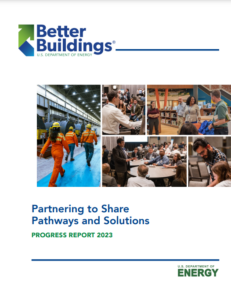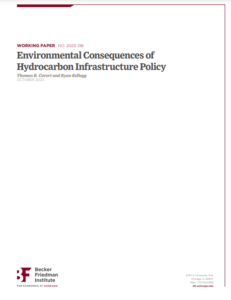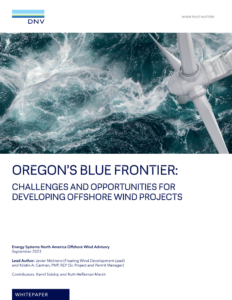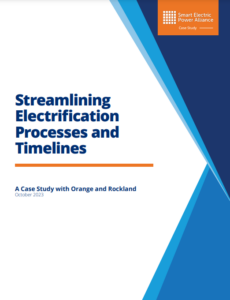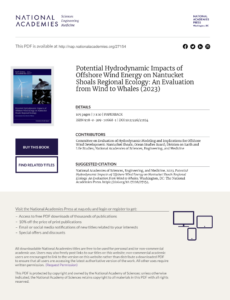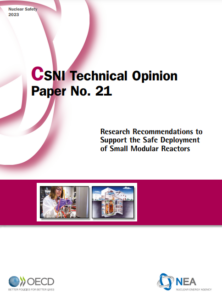The OurEnergyLibrary aggregates and indexes publicly available fact sheets, journal articles, reports, studies, and other publications on U.S. energy topics. It is updated every week to include the most recent energy resources from academia, government, industry, non-profits, think tanks, and trade associations. Suggest a resource by emailing us at info@ourenergypolicy.org.
Resource Library
Through the Better Buildings Initiative, the U.S. Department of Energy (DOE) works with leaders across the nation to develop and deploy solutions that benefit our communities and our planet while strengthening our economy and increasing our competitiveness. Better Buildings partners are pursuing ambitious greenhouse gas (GHG), energy, water, and waste reduction goals, and sharing their proven solutions with the marketplace.
Since the start of the program, partners have collectively saved more than 3 quadrillion British thermal units (QBtu) of energy. This amounts to a savings of more than $18.5 billion. Partners have also reduced their carbon dioxide emissions (CO2) by …
View Full Resource“We study policies that aim to ‘keep carbon in the ground’ by blocking fossil fuel infrastructure investment. Our analysis relies on a model of hydrocarbon production and transportation, incorporating substitution between pipeline infrastructure and flexible alternatives, like crude-byrail. We apply the model to the Dakota Access Pipeline (DAPL), which moves oil from North Dakota to Texas and was controversially completed in 2017. Had DAPL’s construction been enjoined, we estimate that 81% of the blocked pipeline flows would move by rail instead. This substitution induces both private costs and local environmental damage, since rail transport imposes greater local externalities than pipelines.”…
View Full ResourceOregon’s current generation power mix includes hydroelectric power, natural gas, onshore wind, coal, and other small generation sources. Although the state meets its current Renewables Portfolio Standard (RPS) compliance criteria, the prospect of offshore wind in Oregon and floating wind is rapidly evolving—both technically and commercially—to provide a carbon-free alternative energy source.
For companies seeking to success in Oregon’s upcoming offshore wind auction, DNV tapped into their global and local expertise to identify permitting and technical opportunities and challenges. Their insights come from 125 years of helping clients safely and economically develop offshore energy projects and, recently, their involvement in …
View Full ResourceDevelopment zones are vital to China’s economic growth. China is placing greater focus on how to create development zones that are not only economically beneficial but also environmentally sustainable. Carbon-neutral demonstration zones serve as vital tools for exploring effective transition models and developing best practices for China’s overall carbon-neutral transformation.
In this report, they propose a definition and planning methodology for carbon-neutral demonstration zones. The key driver behind this type of demonstration should be a new economic path that promotes the zero-carbon transformation of local industrial innovation and reduces CO2 emissions per unit of GDP. The zone should be established …
View Full ResourceUtilities face challenges establishing contact with fleet managers and building relationships that facilitate smoother electrification processes. Enhancing the understanding of a utility’s service territory’s fleets is crucial for fostering effective communication and nurturing strong relationships between utilities and fleet managers. By bridging the knowledge gaps such as lack of transparency into fleet data, unfamiliarity with new technology, and using electricity as a fuel source, utilities can develop programs that holistically address the unique needs of fleets within their service territory, thereby facilitating a harmonious transition to electrification. This proactive approach helps foster clear communication, minimize delays, and optimize costs, ultimately …
View Full ResourceAs fleet electrification continues to grow, utility companies will see increases in charging infrastructure applications. Today, the processes to install charging infrastructure are inconsistent across utilities and can involve complex timelines. This creates longer lead times for fleet electrification, higher expenses, and poor customer experiences. To prepare for an increase in fleet electrification, utility companies must explore and implement innovative solutions to improve the overall experience for fleet operators and accelerate the transition to EVs.
Orange and Rockland (O&R), a utility that provides services in New York and New Jersey, implemented automation software to identify barriers and inefficiencies within their …
View Full ResourceThe transition to renewable energy has spurred many efforts to scale up the U.S. portfolio of efficient clean energy resources, including the development of offshore wind farms. The Nantucket Shoals region off the coast of Massachusetts is the first large scale wind farm installation under development in U.S. waters. To ensure Nantucket Shoals region offshore wind energy installations are being planned, constructed, and developed in an environmentally responsible way, the Bureau of Ocean Energy Management (BOEM) asked the National Academies to evaluate the potential for offshore wind farms in the Nantucket Shoals region to affect oceanic physical processes, and, in …
View Full ResourceA cybersecurity internship can provide hands-on experience, develop tangible skills, and strengthen your professional network while you’re still in school.
Interns get to take classroom knowledge and practically apply it in the real world. You can use the connections you make at an internship to get letters of recommendation, mentorship and advice, and — in some cases — job offers after graduation.
Adrianna O’Dell, a computer science major, found the cybersecurity internship she completed during her junior year to be a valuable experience. She explained why she chose a cybersecurity internship: “Cybersecurity has always piqued my interest, and being able …
View Full ResourceThe prospect for electric vehicles (EVs) as a climate change solution hinges on their widespread adoption across the political spectrum. In this paper, we use detailed county-level data on new vehicle registrations from 2012-2022 to measure the degree to which EV adoption is concentrated in the most leftleaning U.S. counties, and how this concentration has changed over time. The results point to a strong and enduring correlation between political ideology and U.S. EV adoption. During our time period about half of all EVs went to the 10% most Democratic counties, and about one-third went to the top 5%. There is …
View Full ResourceWhile there is a growing interest in the deployment of small modular reactors (SMRs) as a promising option to help mitigate climate change, further international efforts are needed to accelerate the development and safety demonstration of the innovative technologies that are being considered for many of these SMRs. This publication presents the actions taken by the NEA Committee on the Safety of Nuclear Installations (CSNI) and its expert group on SMRs to define the areas of future CSNI research and safety assessment work needed to support sound safety demonstrations for SMRs. The proposed activities address four areas: support for regulatory …
View Full Resource